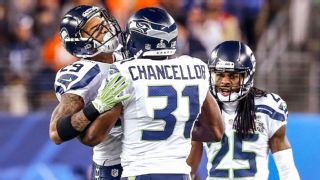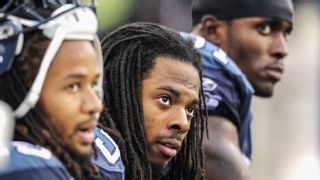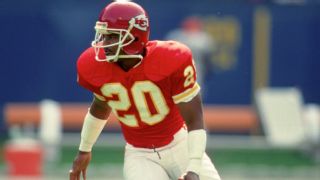|
The question arose seven years ago this month, buried deep in coach Pete Carroll's media session following a 34-12 loss to the Cincinnati Bengals. It was the 23rd question out of 25, sandwiched between queries about backup quarterbacks Josh Portis and Tarvaris Jackson. How had Richard Sherman played in his first NFL start? Carroll, then in his second season as the Seattle Seahawks' coach, had just witnessed the birth of the now-legendary Legion of Boom secondary, except no one knew it then. The coach explained that Sherman had played quite well. "He deserves to start again, that's for sure," Carroll concluded. Sherman, strong safety Kam Chancellor and free safety Earl Thomas would ultimately start 81 regular-season games together, as many as any three players in the same secondary over the past quarter-century. That 2011 defeat to the Bengals remains the only time Seattle lost by more than seven points with those three in the starting lineup together (Cincy scored twice on returns). The Legion of Boom ceased operations last season when injuries precipitated Sherman's release and Chancellor's pending retirement. The season-ending leg injury Thomas suffered Sunday looks like the finishing blow, as Thomas appears likely to depart once his contract expires in March. Few get to go out like John Elway did, hoisting the Lombardi Trophy following his final game with the only team he knew. Sherman departed Seattle accusing management of losing its way. Minutes after Thomas' tibia fractured Sunday, he raised a middle finger toward the Seattle sideline in anger over his contract. Chancellor departed with grace following a neck injury, the only one of the three to receive a third contract from the team. He raised the Seahawks' 12th Man flag for what was probably Thomas' final home game, a Week 3 victory over Dallas featuring two Thomas interceptions. "They're all such extraordinary performers for us and great competitors and iconic players -- in our community, too, with how they've affected it with their play and success and all the flavor that they have brought over the years," Carroll said this week. "It's just amazing that they would get grouped together, that they've been banged up and hurt and all that. I don't know what to make of it." Having all three charter members of the LOB meet their demise as Seahawks in the same Arizona stadium within a calendar year was a lot for Seattle's defensive architect to process. For context, we compare this iconic trio of defensive backs to others with similar staying power over the past four decades, and why it's unlikely we'll see a similar group in the years ahead.
Stacking the iconic secondaries The 81 regular-season starts for Thomas, Chancellor and Sherman as a secondary trio are the most on one team since Deron Cherry, Albert Lewis and Kevin Ross started 82 games for the Kansas City Chiefs from 1984-91. No other secondary trio has started more games together in the 16-game schedule era dating to 1978, according to Elias Sports Bureau research. Troy Vincent, Hall of Famer Brian Dawkins and Bobby Taylor matched the Legion of Boom with 81 starts together. They did it with the Philadelphia Eagles from 1996-2003. The Pittsburgh Steelers' trio of Troy Polamalu, Ike Taylor and Ryan Clark were next, with 79 starts from 2006-13. These DB trios with the most staying power since 1978 combined for 41 Pro Bowl appearances, 17 first-team All-Pro selections and 275 interceptions during the seasons in which they started together. The Legion of Boom stacks up well against these other enduring secondaries, with strong competition from the Chiefs trio. Pro Bowls and first-team All-Pro selectionsThomas, Sherman and Chancellor combined for 14 Pro Bowls and six first-team All-Pro selections during their 2011-17 run as starters together. Both figures rank No. 1 when stacked against these three other DB trios during the seasons when they started together, according to Pro Football Reference data. Combined Approximate Value during runPro Football Reference developed Approximate Value to create a single number representing quality of player contributions based on a mix of team and individual accomplishments. Games played, starts, Pro Bowls, All-Pro selections and team success all play roles in the equation. Peyton Manning (271), Tom Brady (255), Brett Favre (255), Jerry Rice (250) and Drew Brees (239) own the highest career Approximate Values. These four secondaries stacked up closely when using Approximate Value. I also calculated their AV totals as a percentage of the total AV for the three highest-rated DBs in the league (regardless of team) over the years in question. The Seattle and Kansas City trios each had two of the NFL's three highest-valued DBs during the relevant question. The Legion of Boom again came out No. 1 compared to these other enduring trios. Its combined 212 AV from 2011-17 was 85 percent of the total for the NFL's three highest-rated DBs during those years: Patrick Peterson (88), Sherman (86) and Thomas (76). Chancellor was 10th in the league at 50 over those seasons, right behind Darrelle Revis. The Kansas City trio of Cherry, Lewis and Ross had the highest bar to clear compared to their peers in the NFL at the time. Ronnie Lott (102), Darrell Green (82) and Joey Browner (81) were the top three DBs from 1984-91, gobbling up 18 Pro Bowl appearances and nine first-team All-Pro selections during those years. Cherry (76) and Lewis (70) were right behind them on the AV list. Ross was 15th. The 1996-2003 Eagles trio was competing against Rod Woodson (84), Vincent (83) and John Lynch/Aeneas Williams (81 apiece) in those years. The Steelers' trio was up against Ed Reed (97), Polamalu (83) and Revis (76) from 2006-13. Who wins the era-adjusted INT battle? The Chiefs' exalted trio of Cherry, Lewis and Ross combined for the most interceptions and it wasn't close, but they also played in an era when quarterbacks tossed picks more freely. Quarterbacks threw interceptions on 3.9 percent of pass attempts when Kansas City's trio was starting from 1984-91, compared to 2.6 percent during the Legion of Boom era. To adjust for this to some degree, I compared these leading DB trios' combined interception totals across their starting seasons to the total for the NFL's top three interceptors during the same seasons. The Legion of Boom's three charter members combined to pick off 64 passes from 2011-17. The NFL's top three interceptors during those years -- Sherman (32), Reggie Nelson (27) and Eric Weddle (23) -- had 82 picks. The Seattle trio picked off 78 percent as many passes as the top three, the highest percentage for any of these four enduring secondaries. The Chiefs were at 73 percent. Sherman (first), Thomas (seventh) and Chancellor (12th) all ranked among the top 15 for interceptions during their starting seasons together. The same was true for Cherry (third), Lewis (12th) and Ross (12th) during their era. The Eagles' Vincent (12th), Dawkins (33rd) and Bobby Taylor (60th) were not as prolific. Neither were Polamalu (seventh), Clark (73rd) or Ike Taylor (73rd). Can the Chiefs claim an edge? The Legion of Boom flourished in a system based on Carroll's defensive philosophy and techniques, which had been honed for decades. Carroll played safety in college and coached the secondary for years at the college and NFL levels. He personally implemented his vision for the defense and its secondary from beginning to end of the LOB's run. That's an advantage. While the LOB deserves some credit for sustaining enough success to maintain continuity, what if Seahawks ownership had made a coaching change after Seattle posted 7-9 records in each of Carroll's first two seasons? Would Sherman, then just getting started, have fit the new system as a longer corner who was not prototypical in terms of speed and quickness? Would the secondary have played as well overall? Would the team have signed all three to second contracts? The Eagles' iconic secondary succeeded under Ray Rhodes and then Jim Johnson. Their counterparts from the Steelers played in Dick LeBeau's defensive scheme all the way through. That continuity was an advantage. This is where the Chiefs trio can claim an edge. Kansas City was an organization in flux. Cherry, Lewis and Ross played under three head coaches and five defensive coordinators from 1984-91. They endured across different schemes requiring different techniques: mostly zone under Dan Daniel, then matchup zone under Walt Corey, then lots of Cover 2 under John Paul, then back to matchup zone under Rod Rust, and then mostly man with dual coverage calls predicated on motion under Bill Cowher. That Kansas City secondary, rounded out by Lloyd Burruss for a good chunk of that 1984-91 run, dominated through the regular scheme changes. Elway passed for 10 touchdowns and 20 interceptions while facing the Chiefs from 1984-91, the years when Cherry, Lewis and Ross combined for their 82 starts together. Fellow Hall of Fame QBs Dan Marino, Warren Moon, Jim Kelly and Dan Fouts combined for 22 touchdowns and 18 picks against them during those years. Elway's most productive years were yet to come and Fouts was on the downside by then. Still, that's 32 touchdowns and 38 picks for Hall of Fame QBs against that Chiefs secondary. NFL quarterbacks were tossing 1.06 touchdowns per interception in the league overall during those years. "When you look at the quarterbacks we went up against during that period, I have to consider us one of the best groups that ever played the game," Cherry said. "But I give those guys, in the era they are playing, a lot of credit, especially that Seattle group." As Cherry noted, it's tough keeping together a group that long simply from a health standpoint. To play well enough for long enough to develop what these secondaries developed takes special players, and probably some luck. Years from now, when the Legion of Boom is blessed with the perspective that comes with time, they might be better able to appreciate what has now passed. "You think of 81 consecutive starts together playing, that is quite an accomplishment," Cherry said. "When you have the ability to play together for so long, you can think about situations on the field where it was just second nature because you were on the field so much and studied so much film together that you knew what the other guy was thinking. That is what made you a more cohesive unit and, more importantly, a more successful unit."
|

